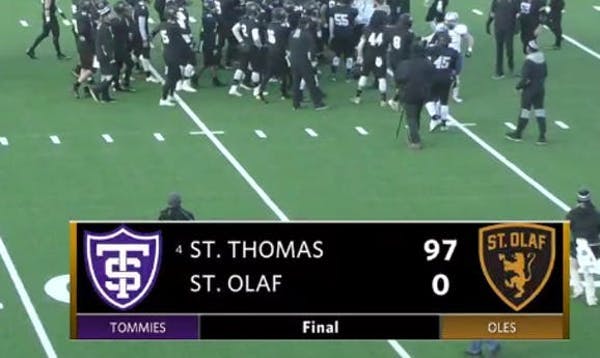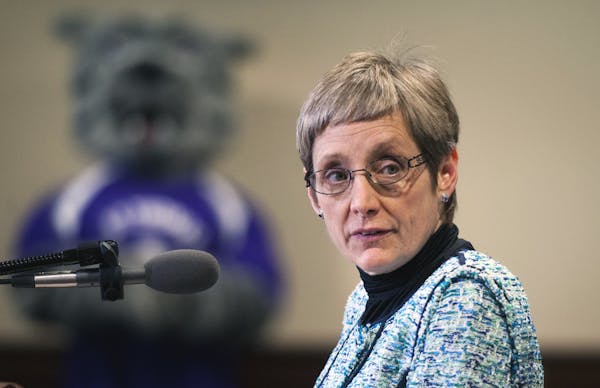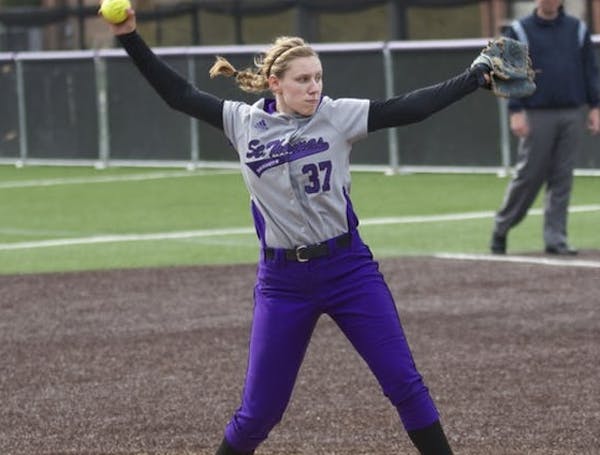St. Thomas has become too dominant for the MIAC's liking, especially in football, and now the Tommies are being kicked out of the league they helped form 99 years ago.
The Minnesota Intercollegiate Athletic Conference announced Wednesday that after extensive discussions, St. Thomas will be "involuntarily removed from membership." The four-sentence news release said the MIAC Presidents' Council cited athletic competitive parity as its primary concern for the move.
St. Thomas, an original member of the MIAC dating to 1920, will compete in the MIAC through the spring of 2021.
"It's sad day. We're disappointed with the outcome," St. Thomas athletic director Phil Esten said. "We had hoped to find a way to stay in the MIAC. … Ultimately, it was just absolutely inevitable that wasn't going to happen."
St. Thomas now must decide its athletic future. Options include finding a new Division III conference, jumping to Division II or beginning a climb to Division I, a process that would take 12 years.
The league's presidents had for weeks been considering an ouster of St. Thomas, a St. Paul school with an undergraduate enrollment of 6,199, about two times bigger than the next-largest MIAC schools. Votes from nine of the league's 13 schools would have been needed to oust St. Thomas, and school presidents this week apparently had the votes secured to make the move.
St. Thomas, St. John's, St. Benedict and possibly Bethel were against the move, sources said. Sources also told the Star Tribune earlier this month that the presidents seeking to oust St. Thomas would push the MIAC to change its bylaws, instituting an enrollment cap.
"St. Thomas expended tremendous effort to remain in the MIAC and stabilize the conference," St. Thomas President Julie Sullivan said in a statement "However, the presidents came to a consensus that the conference itself would cease to exist in its current form if St. Thomas remained."
Sullivan and Esten met with about 140 of the school's varsity athletes Wednesday, answering several questions in a session that stretched for more than an hour.
The effort to oust St. Thomas was conducted in secret, with officials of the MIAC and its other schools declining to comment. That stance continued Wednesday, with spokespersons for five school presidents referring to the MIAC statement.
While the Tommies have won the MIAC's men's and women's all-sports titles in each of the past 11 seasons, their football dominance rubbed some members the wrong way. Since Glenn Caruso took over as coach in 2008, the Tommies have won six conference titles and played in two NCAA Division III championship games. They routinely have blown out conference opponents, with nine MIAC victories by 50 or more points in the past two seasons.
The tipping point for many, a source told the Star Tribune, was the Tommies' 97-0 romp at St. Olaf in 2017.
Last year, St. Thomas went 8-2 overall and 6-2 for third place in the MIAC, its lowest placement in Caruso's 11 years.
Esten, a St. Thomas alumnus who took over his role in January, acknowledged that football gets the most attention but that the success of the Tommies' entire athletic department prompted the MIAC's decision.
"This is about the competitiveness across the board," he said.
Now, Esten and St. Thomas turn their focus to finding a conference — and determining the level — in which to play.
"We need to assess all our options, take a look at what we think is best for St. Thomas and work hard to receive an invitation to wherever that might be," he said. "All options that are available to us are on the table."
If St. Thomas stays in Division III, a possible home is the Wisconsin Intercollegiate Athletic Conference (WIAC). The league consists of eight schools, but Commissioner Gary Karner said last week that the WIAC is open to adding programs, even from outside Wisconsin.
Should St. Thomas want to explore Division II, the Northern Sun Intercollegiate Conference, which has nine Minnesota teams among its 16, is a possibility. Augustana (S.D.) is making the move to Division I, creating an opening.
One issue for St. Thomas if it went to Division II: Its men's and women's hockey teams could no longer play at the Division III level. The Tommies, with no Division II hockey option, would be forced to play in Division I. Starting programs at college hockey's highest level is an expensive undertaking.
If St. Thomas wants to move all its programs to Division I, it first must go through a three-year process of transitioning to Division II, then stay at that level for five years. The move from Division II to Division I requires a four-year period, so that's a 12-year commitment to move from Division III to Division I.
The move to expel St. Thomas from the conference will at least alter the league's marquee event, the St. Thomas-St. John's football rivalry. The two football powers have played 88 times, and the 2017 game drew a Division III record crowd of 37,355 at Target Field. This year's game will be played at Allianz Field, the 19,400-seat stadium in St. Paul that is home of the Minnesota United soccer team.
While acknowledging the difficult day, Esten looked ahead.
"This is less 'the last day for us in the MIAC' and more 'the first day of whatever's next for St. Thomas,' " he said. "We're going to attack what's next like we attacked the last 99 years in the MIAC."
Staff writer Mara Klecker contributed to this report.
![Naz Reid (11) of the Minnesota Timberwolves Wednesday, March 27, 2024, at Target Center in Minneapolis, Minn. ] CARLOS GONZALEZ • carlos.gonzalez@](https://arc.stimg.co/startribunemedia/TGYNEKQCYNH5VEPCXSJODRMDDM.jpg?h=91&w=145&fit=crop&bg=999&crop=faces)
Naz Reid's path to breakout stardom featured mentor unlike any other

Scoggins: Finch feeling heat of the Suns as playoff battle looms

Meet the Athena Award winners: 103 female athletes picked by their schools
Israeli soccer facing Palestinian calls for action by FIFA at annual congress



